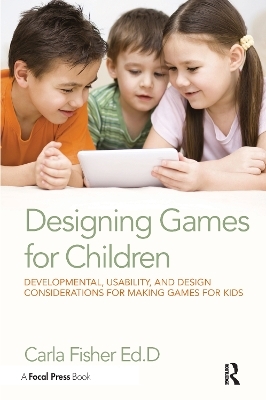
Designing Games for Children
Routledge (Verlag)
978-0-415-72917-8 (ISBN)
When making games for kids, it’s tempting to simply wing-it on the design. We were all children once, right? The reality is that adults are far removed from the cognitive changes and the motor skill challenges that are the hallmark of the developing child. Designing Games for Children, helps you understand these developmental needs of children and how to effectively apply them to games.
Whether you’re a seasoned game designer, a children's media professional, or an instructor teaching the next generation of game designers, Designing Games for Children is the first book dedicated to service the specific needs of children's game designers. This is a hands-on manual of child psychology as it relates to game design and the common challenges designers face.
Designing Games for Children is the definitive, comprehensive guide to making great games for kids, featuring:
Guidelines and recommendations divided by the most common target audiences – babies and toddlers (0-2), preschoolers (3-5), early elementary students (6-8), and tweens (9-12).
Approachable and actionable breakdown of child developmental psychology, including cognitive, physical, social, and emotional development, as it applies to game design
Game design insights and guidelines for all aspects of game production, from ideation to marketing
Chances are high that most American children have played some of the more than 300 games Dr. Carla Fisher has worked on in the past 15 years. Prior to starting No Crusts Interactive, she worked for Sesame Workshop, PBS KIDS, and Highlights for Children. She speaks internationally at both industry and academic events about best practices for children's games, and holds a doctorate in education from Teachers College, Columbia University. Additionally, Carla holds a master's degree in media studies from the New School University and has, on occasion, been known to twist balloon animals and hats as well as play bassoon.
Section One: Game Design in a Nutshell Chapter 1: What is a Game? Chapter 2: What is Game Design? Chapter 3: Game Design Documents Chapter 4: Production Chapter 5: Finding a Developer Chapter 6: Game Business Models Chapter 7: Competitive Analysis and Identifying Market Opportunities Section Two: Understanding Kids Chapter 8: Child Development Overview Chapter 9: Babies and Toddlers (0-2 Years) Chapter 10: PreSchoolers (3-5 Years) Chapter 11: Early Elementary Kids: (Ages 6-8) Chapter 12: Tweens (Age 9-12) Chapter 13: Teens (Age 13+) Chapter 14: Public Perceptions of Games for Kids Chapter 15: User Testing with Kids Section Three: Game Design Guidelines Chapter 16: Best Practices Chapter 17: Considerations for Interactions by Platforms or Device Chapter 18: Making Educational or Commercial Games Chapter 19: Instructions, Tutorials, Scaffolding, and In-Game Help Chapter 20: eBooks and Interactive Stories Chapter 21: Multiplayer and Cooperative Games Chapter 22: Player Data in Games and Progress Tracking Chapter 23: Marketing for Kids and Families Conclusion: Making a Game
| Zusatzinfo | 1 Tables, color; 5 Line drawings, color; 70 Halftones, color; 170 Illustrations, color |
|---|---|
| Verlagsort | London |
| Sprache | englisch |
| Maße | 152 x 229 mm |
| Gewicht | 544 g |
| Themenwelt | Kunst / Musik / Theater |
| Informatik ► Grafik / Design ► Film- / Video-Bearbeitung | |
| Informatik ► Software Entwicklung ► Spieleprogrammierung | |
| Informatik ► Weitere Themen ► Computerspiele | |
| Sozialwissenschaften ► Pädagogik ► Vorschulpädagogik | |
| ISBN-10 | 0-415-72917-3 / 0415729173 |
| ISBN-13 | 978-0-415-72917-8 / 9780415729178 |
| Zustand | Neuware |
| Informationen gemäß Produktsicherheitsverordnung (GPSR) | |
| Haben Sie eine Frage zum Produkt? |
aus dem Bereich


